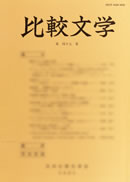35 巻
選択された号の論文の28件中1~28を表示しています
- |<
- <
- 1
- >
- >|
追悼文
-
1993 年 35 巻 p. 9-12
発行日: 1993/03/31
公開日: 2017/07/31
PDF形式でダウンロード (1058K) -
1993 年 35 巻 p. 13-15
発行日: 1993/03/31
公開日: 2017/07/31
PDF形式でダウンロード (665K) -
1993 年 35 巻 p. 16-20
発行日: 1993/03/31
公開日: 2017/07/31
PDF形式でダウンロード (1348K) -
1993 年 35 巻 p. 21-23
発行日: 1993/03/31
公開日: 2017/07/31
PDF形式でダウンロード (719K)
論文
-
原稿種別: 〈芥川小特集〉
1993 年 35 巻 p. 25-37
発行日: 1993/03/31
公開日: 2017/06/17
PDF形式でダウンロード (3797K) -
原稿種別: 〈芥川小特集〉
1993 年 35 巻 p. 39-49
発行日: 1993/03/31
公開日: 2017/06/17
PDF形式でダウンロード (3360K) -
原稿種別: 〈芥川小特集〉
1993 年 35 巻 p. 51-61
発行日: 1993/03/31
公開日: 2017/06/17
PDF形式でダウンロード (3367K) -
1993 年 35 巻 p. 63-74
発行日: 1993/03/31
公開日: 2017/06/17
PDF形式でダウンロード (3791K) -
1993 年 35 巻 p. 75-88
発行日: 1993/03/31
公開日: 2017/06/17
PDF形式でダウンロード (4163K) -
1993 年 35 巻 p. 89-101
発行日: 1993/03/31
公開日: 2017/06/17
PDF形式でダウンロード (3447K) -
1993 年 35 巻 p. 103-115
発行日: 1993/03/31
公開日: 2017/06/17
PDF形式でダウンロード (3834K) -
1993 年 35 巻 p. 117-128
発行日: 1993/03/31
公開日: 2017/06/17
PDF形式でダウンロード (3590K) -
1993 年 35 巻 p. 129-139
発行日: 1993/03/31
公開日: 2017/06/17
PDF形式でダウンロード (3354K) -
1993 年 35 巻 p. 266-247
発行日: 1993/03/31
公開日: 2017/06/17
PDF形式でダウンロード (5253K)
研究ノート
-
1993 年 35 巻 p. 141-150
発行日: 1993/03/31
公開日: 2017/06/17
PDF形式でダウンロード (3115K) -
1993 年 35 巻 p. 151-166
発行日: 1993/03/31
公開日: 2017/06/17
PDF形式でダウンロード (4598K)
<比較文学の古典発掘>Ⅴ
-
1993 年 35 巻 p. 167-177
発行日: 1993/03/31
公開日: 2017/07/31
PDF形式でダウンロード (3522K)
書評
-
1993 年 35 巻 p. 179-182
発行日: 1993/03/31
公開日: 2017/07/31
PDF形式でダウンロード (1252K) -
1993 年 35 巻 p. 182-186
発行日: 1993/03/31
公開日: 2017/07/31
PDF形式でダウンロード (1573K) -
1993 年 35 巻 p. 186-189
発行日: 1993/03/31
公開日: 2017/07/31
PDF形式でダウンロード (1323K) -
1993 年 35 巻 p. 189-193
発行日: 1993/03/31
公開日: 2017/07/31
PDF形式でダウンロード (1696K) -
1993 年 35 巻 p. 193-198
発行日: 1993/03/31
公開日: 2017/07/31
PDF形式でダウンロード (1997K) -
1993 年 35 巻 p. 198-201
発行日: 1993/03/31
公開日: 2017/07/31
PDF形式でダウンロード (1424K) -
1993 年 35 巻 p. 202-205
発行日: 1993/03/31
公開日: 2017/07/31
PDF形式でダウンロード (1289K) -
1993 年 35 巻 p. 205-209
発行日: 1993/03/31
公開日: 2017/07/31
PDF形式でダウンロード (1656K) -
1993 年 35 巻 p. 209-213
発行日: 1993/03/31
公開日: 2017/07/31
PDF形式でダウンロード (1500K) -
1993 年 35 巻 p. 213-216
発行日: 1993/03/31
公開日: 2017/07/31
PDF形式でダウンロード (1173K)
-
1993 年 35 巻 p. 246-232
発行日: 1993/03/31
公開日: 2017/07/31
PDF形式でダウンロード (3459K)
- |<
- <
- 1
- >
- >|
